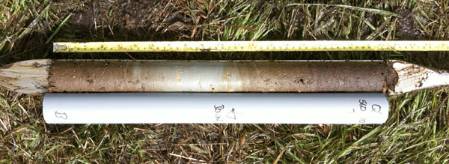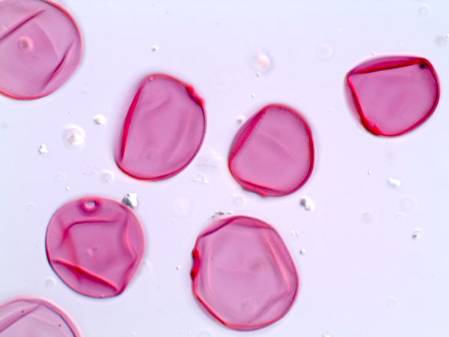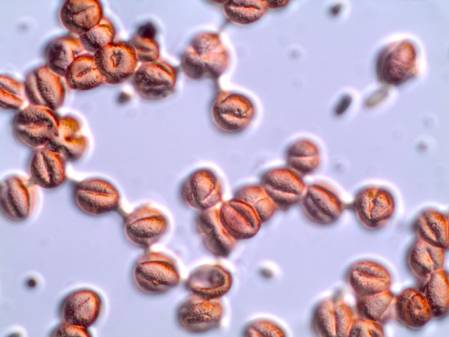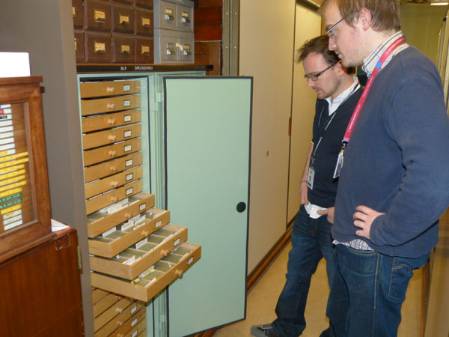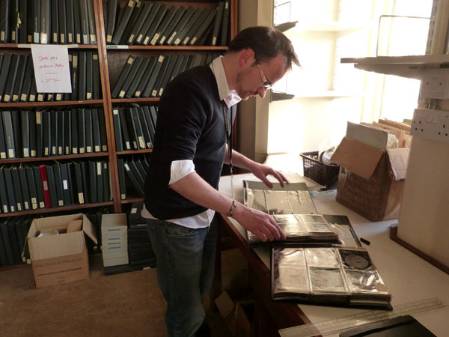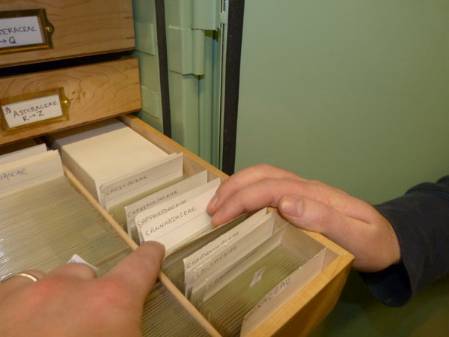In January we transferred the Botany Palynology (pollen and spore) Collection to a new location within the micropalaeontology collections. The collection includes 32,500 glass microscope slides and 155 files of images of pollen and spores from named living plants from worldwide locations. So why should we be interested in moving this collection to the Palaeontology Department?
This collection is already being used by Earth Science staff studying the contents of fossil hyena dung, evidence of early human agricultural activity and changes in the landscape over approximately the last 2.5 million years as a result of climate change. The collection also has potential for supporting forensic studies to help solve crime.
Dr Tom Hill taking great pride in wheeling a trolley of pollen and spore slide cabinets past the giant Sequoia in the main hall of the museum. For health and safety reasons we were only able to move the collection before the Museum opened to the public.
In one of my first blog posts - what is micropalaeontology? - I mentioned that there is not always a clear distinction between fossil and extant (living) collections and this is very much the case here. This is an important collection for palynologists looking to reconstruct environments over the the Quaternary Period which covers approximately the last 2.5 million years as many of the plant species present today are represented in the Quaternary fossil record.
Pollen and spore grains have an outer wall of an extremely resistant material known as sporopollenin so are widespread in both fossil and recent terrestrial and near shore sediments. Most are smaller than 50 microns so relatively small samples can produce thousands of pollen grains of species diagnostic of particular climatic conditions.
Some of Tom's Holocene core from Somerset, showing a lighter estuarine layer between freshwater peats.
Dr Tom Hill of the Earth Sciences Department at the Museum is analysing pollen from sediments from Somerset that cover the Holocene Epoch (i.e. the last 11,500 years). He collected them using a sedimentary corer, which is essentially a larger version of an apple corer that is inserted into the ground to extract deposits preserved beneath our feet. He said, 'by taking sediment samples at regular intervals throughout the sediment sequence, you are able to develop ‘snapshots’ of what the landscape looked like every few hundred years.'
Tom doing fieldwork with a sediment corer in a 'real field' at Shapwick Heath Nature Reserve.
The landscape changed in response to climate and human activity: an abundance of tree pollen suggests that woodlands dominated the landscape while shrubs, herbs and grasses infer an open grassland setting. 'Shifts from woodlands to grasslands are often indicators of human activity in the form of deforestation; the earliest cereal pollen found in these deposits is an indicator of the onset of agriculture during the Holocene' according to Tom.
Hordeum secalinum - barley, BM10490. Cereal crop pollen grains like these are much larger than average (>40 microns), are typically round with a single opening (pore) and indicate periods of cultivation during prehistory. Photo Tom Hill.
Artemisia - mugwort, BM8975_1. This species/genus thrives on bare ground with immature soil and is often found in sediments accumulated during cold periods such as late glacial episodes in the Earth's history. Photo Tom Hill.
Mark Lewis of the Ancient Human Occupation of Britain (AHOB) Project has been using the distribution of pollen from sediments and hyena coprolites (fossil dung), to reconstruct Quaternary environments. Coprolite pollen is useful in situations where sedimentary pollen is absent, for example in caves, where evidence of early humans is sometimes found. Pollen grains can occasionally be reworked from older sediments so analysis of coprolites alongside sediments associated with early human finds can be a useful test to see if the pollen has been preserved in situ.
Mark worked on pollen assemblages from Happisburgh, where the earliest evidence of human activity in Britain has been uncovered from c.850,000 year old sediments (for details of their publication in Nature see my previous post on what microfossils tell us about the early humans in Britain). These pollen assemblages showed the climatic setting of the finds and led to breakthroughs in the understanding of early human behaviour, adaptation and survival.
Both Mark and Tom are actively using this collection for their research by checking identifications of plant species represented by pollen in their samples. Catalogues, including 8 volumes published by the Northwest European Pollen Flora Project, provide 2-dimensional reference images of pollen but there is no substitute for examining museum reference collections like this one under a microscope. 'The collection provides the user the opportunity to look at numerous examples of an individual species present on a single slide, and review that species in multiple orientations' said Mark Lewis.
Micropalaeontologists/palynologists Steve Stukins and Tom Hill examining the Northwest European part of the pollen and spore collection in its new home in the Palaeontology Building of the Earth Science Department.
The Northwest European part of this collection is particularly well ordered thanks to Dr Peter Stafford, Palynologist at the Museum until his death in 2009 who was a major contributor to the collection and publication of the Northwest European Pollen Flora volumes. He worked with many palynologists including Mark Lewis and Prof Steve Blackmoor, former Keeper of the Botany Department. As a result it is now possible to locate examples of the pollen and spores of a named Northwest European plant with ease.
Tom in the old Botany tower examining some of the 155 folders of scanning electron microscope images of pollen and spores prior to their transfer to the Palaeontology Building.
The remainder of the 32,500 glass slide collection is currently housed in old metal drawers that do not conform to current storage standards and will need to be transferred into a cabinet next to the Northwest European collection. A start has been made by volunteers and students to rehouse the slides in special conservation grade sleeves but there is much work remaining to be done.
While I am very glad that this collection has been moved to our department, it would take me the rest of my career to carry out this task alongside the other collections management responsibilities that I have. As a result Tom Hill will shortly be advertising a couple of volunteer opportunities to help re-arrange the remaining part of this important collection.
Slides of pollen from cannabis plants housed in special conservation sleeves in the Northwest European Collection.
Finding slides from cannabis plants jogged my memory to mention that while we anticipate that Quaternary palynologists will be the main users of the collection, there are applications for this collection beyond Palaeontology. Pollen grains present in mud on shoes or in tyre treads have been used to link suspects to crime scenes. This collection has potential to act as a reference for forensic palynologists as well as those looking to study the Quaternary.
Finally a big thank you to Tom Hill, Steve Stukins and Jo Wilbraham for help with transferring this important collection from Life to Earth Sciences and to Mark Lewis for providing details of the history of the collection and his research. The collection is available to - and will hopefully continue to be used by - both Life and Earth Scientists.




